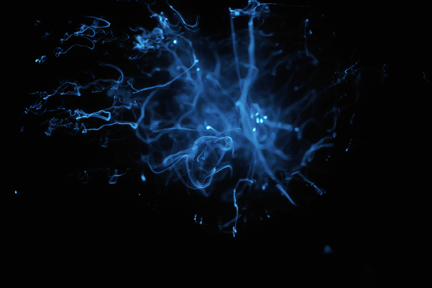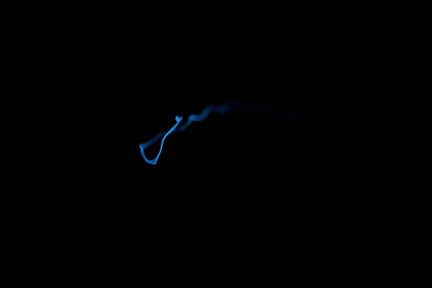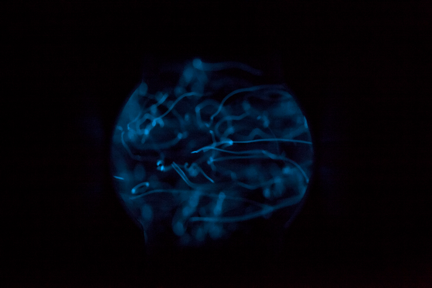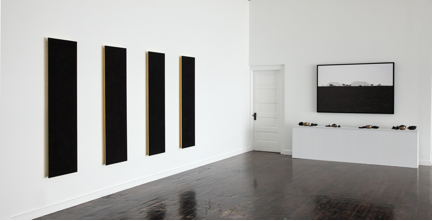BIOLUMINESCENCE & WILDFIRES
- Published: Thursday, January 22 2015 21:19

Erika Blumenfeld
Title: Living Light No. 2 (Pyrocystis Fusiformis)
Date: 2011
Medium: Archival digital pigment print
Dimensions: 40x60 inches
In collaboration with Dr. Michael Latz, Marine Biologist, Scripps Institution of Oceanography
Description: In Living Light No. 2 (Pyrocystis Fusiformis), the expression of bioluminescence was instigated by the artist's own hand. The artist lightly tapped the container containing the bioluminescence, sending a manual pulse through the seawater that triggered their flashing. Each light trajectory represents the response of a single organism within the population, dramatically showing their bioluminescence expressed at the microscopic scale of the organism.
In 2001, I arrived at a new question in my art practice: could I work with bioluminescence as both subject and material for art-making. My inquiry led me to initiate a collaboration with Marine Biologist Dr. Michael Latz at Latz Laboratory at the Scripps Institution of Oceanography in 2001 and then again in 2011. My intent was to learn about the wondrous life and cycles of marine bioluminescence, and document these organisms as means to reflect on our natural environment and our relationship to it.
Marine bioluminescence – literally, living light – is widespread in the oceans of the world. Light emission is produced as a result of a chemical reaction involving the oxidation of a substrate molecule called luciferin. In the deep sea, where sunlight is absent, more than 90% of the animals are luminescent. In coastal regions, the primary source of bioluminescence is dinoflagellates, single-celled microscopic organisms that are common members of the plankton.
The Bioluminescence series currently consists of photo and video-based works. In the large-scale photographic works in the installation view below, the bioluminescence’s glow and movement was instigated by my own hand. In an unpremeditated manner, I lightly tapped the pouch containing the bioluminescence, sending a vibration through the seawater that triggered their glow. Each spot and trace of light is a single organism within the population, showing their luminescent phenomena at the scale of the organism.

Erika Blumenfeld
Left: Living Light No. 2 (Pyrocystis Fusiformis), 2011
Middle: Living Light No. 4 (Pyrocystis Fusiformis), 2011
Right: Living Light No. 3 (Pyrocystis Fusiformis), 2011
Digital pigment prints
40x60 inches (101.60x152.4 cm), each
In collaboration with Dr. Michael Latz, Marine Biologist, Scripps Institution of Oceanography
Installation view: Espace Fondation EDF, Paris, France, 2012, Carbon 12 (Group exhibition) Photo by: Laurent Lecat
In Bioluminescence Vol. 1 (Pyrocystis Fusiformis), a suite of eight photographs one of which is shown below, the bioluminescent organisms were propelled through an agitation chamber, which creates an entirely chaotic environment. In science, this experiment is designed to study the physics of a turbulent flow field, and emulates the natural turbulent state of the ocean. I used this equipment to stimulate the glow of the bioluminescence in a controlled environment. By working with a low concentration of organisms and a slow flow rate, I was able to produce single flash events, which depicts the luminous expression of individual organisms.

Erika Blumenfeld
Title: From Bioluminescence Vol. 1(Pyrocystis Fusiformis)
Date: 2011
Medium: 1 print in a suite of 8 archival digital pigment prints housed in an embossed handmade portfolio box
Dimensions: 17x22 inches, each
In collaboration with Dr. Michael Latz, Marine Biologist, Scripps Institution of Oceanography
In the video-based work, Moving Light: Bioluminescence, I recorded the bioluminescent organisms as they were propelled through an agitation chamber, which creates a turbulent flow field like that of the ocean. Using a high concentration of organisms and a high flow rate, I was interested in showing the luminous response of a large population of organisms. The piece depicts the bio-expression of bioluminescence in real time, and shows the turbulent flow field in motion.

Erika Blumenfeld
Title: Still from Moving Light: Bioluminescence
Date: 2011
Medium: Video Installation (00:11:00, looped, silent)
Dimensions variable
In collaboration with Dr. Michael Latz, Marine Biologist, Scripps Institution of Oceanography
In spite of the fact that phytoplankton are mostly microscopic and seemingly disconnected from our daily existence, phytoplankton produce at least 50% of the air we breathe, making them a crucial part of each of our lives, as well as essential to the Earth’s respiratory system. As our industries cause increased toxification of Earth’s water systems, and as anthropogenic climate disruption cause ocean temperature fluctuations and increased acidification, scientific studies have shown that phytoplankton are at risk, some studies showing that populations may be down by as much as 40 percent. Losing populations of phytoplankton is like losing a forest of trees, and we need both the phytoplankton and the forests in order to sustain life.
In considering this further, our forests are at risk as well, and in 2011, I inititated another body of work documenting the increasing number of wildfires that have been ravaging the forests in the United States and countries all over the globe. Anthropogenic climate disruption is placing great strain on Earth’s natural water cycle, and this has become increasingly evident in the severe and intensifying drought, wildfires and flooding throughout the world. The Wildfire series arose as a reflection on the climate change induced wildfires that are occurring in drought regions, especially in the western half of the United States. When I began the series in 2011, the National Oceanic and Atmospheric Administration (NOAA) had already ranked that year as having seen the largest amount of acreage burned in the US from wildfires than the twelve years previous. In just the first six months, 6,091,571 acres burned across the US, which is nearly double the yearly average recorded between 2001 and 2010, and nearly one million acres more than the year-to-date average. By the summer of 2013, the NOAA’s Climactic Data Center announced that moderate to exceptional “drought” covered more than 44% of the United States, and this month they announced that 2014 was the warmest year on record. Many climate scientists see this aridification process not as a drought, which implies an end point, but as an ongoing trend—one that will continue to intensify in the years ahead.
I have documented five major wildfires in four states thus far, including the Rock House Wildfire (Texas 2011) which burned 314,444 acres over 34 days, the Wallow Wildfire (Arizona 2011) which burned 538,049 acres over 35 days, the Las Conchas Wildfire (New Mexico 2011) which burned 156,593 acres over 39 days, the Waldo Canyon Wildfire (Colorado 2012) which burned 18,247 over 18 days in a populated area, and finally, the Silver Wildfire in the Gila National Forest (New Mexico 2013) which burned 138,705 acres in 35 days.
My process consists of collecting the raw charred natural remains from the burned landscape and photographing the smoke-filled air and blackened earth. For the Wildfire Paintings, I hand-grind the collected burned debris—carbonized trees and bark, dirt, animal bones, cacti, grasses, pine cones and needles—from each wildfire into a fine carbon pigment and then adhere it to a gilded-edged panel, allowing the raw material to sit on the surface. Each wildfire pigment varies slightly depending on each location’s indigenous flora and fauna as well as how hot the fire burned. Certain of the wildfire carbon pigments are highly iridescent due to higher concentrations of material that turned to graphite, while others are more matte from the material that turned to charcoal.

Erika Blumenfeld
Installation view: Ballroom Art Space, Marfa, Texas, 2012, Carbon 13 (Group exhibition)
From left to right:
Title: Wildfire Painting: Rock House Wildfire (Texas 2011)
Date: 2012
Medium: Handmade wildfire carbon pigment: burned grasses, dirt, animal bones, cacti. Acrylic medium, 23 karat gold leaf, varnish
Dimensions: 65.5 inches x 17 inches x 2.5 inches
Title: Wildfire Painting: Wallow Wildfire (Arizona 2011)
Date: 2012
Medium: Handmade wildfire carbon pigment: burned trees, pine needles, pine cones. Acrylic medium, 23 karat gold leaf, varnish
Dimensions: 65.5 inches x 17 inches x 2.5 inches
Title: Wildfire Painting: Las Conchas Wildfire (New Mexico 2011)
Date: 2012
Medium: Handmade wildfire carbon pigment: burned trees, pine cones, pine needles, grass. Acrylic medium, 23 karat gold leaf, varnish
Dimensions: 65.5 inches x 17 inches x 2.5 inches
Title: Wildfire Painting: Waldo Canyon Wildfire (Colorado 2012)
Date: 2012
Medium: Handmade wildfire carbon pigment: burned trees, pine cones, pine needles. Acrylic medium, 23 karat gold leaf, varnish
Dimension: 65.5 inches x 17 inches x 2.5 inches
Title: Charred Earth: Rock House Wildfire (Marfa, Texas 2011)
Date: 2012
Medium: Archival digital pigment print
Dimensions: 40 x 60 inches
Title: An Offering to Stolen Nature)
Date: 2012
Medium: Wildfire burned debris (volcanic rock, trees, grass, pine needles, pine cones, animal bones, bark, cacti, dirt) and hand-hammered Tibetan song bowls: Wallow Wildfire 2011 (AZ: Apache National Forest) ), Rock House Wildfire 2011 (TX: Private land, Marfa & Davis Mountains State Park) ), Waldo Canyon Wildfire 2012 (CO: Pike National Forest) ), Las Conchas Wildfire 2011 (NM: Bandalier National Monument, Los Alamos, & Valles Caldera National Preserve) )
In the charred debris installations, I fill hand-hammered Tibetan song bowls with the most delicate charred material, and display them alongside the more robust material in various configurations. All of these materials were collected from land that was private, state, or federally owned. At many of the locations where I gathered debris I was asked to leave, and in one case was asked to put back the burned material I had collected. These pieces consider the innate sacredness of nature alongside the human desire to own and manage it, exploring the question: have our ideas about land ownership in one sense stolen the land from nature itself? These works intend to re-sacralize nature beyond our possession of it. As such, many of the debris installations are not for sale.

Erika Blumenfeld
Title: Fire Mandala: Spiral No. 1 (Silver Wildfire: Gila National Forest, New Mexico 2013)
Date: 2013
Medium: Installation with wildfire burned debris (rocks, trees, pine needles, pine cones, bark, cacti, dirt) and hand-hammered Tibetan song bowls
Installation view: Woman & Their Work, Austin, TX, Water, water every where… (Solo exhibition 2013)
In the photo-based works, I document the thick smoke of the active fires and the blackened landscape in the aftermath of fire’s blaze, as well as the flora and fauna that fell in its wake. They become an archive of the lost or changed environment.
The Wildfire works are the forensic evidence of the crime of anthropogenic climate disruption, a eulogy to the wildfires that ravaged the land, and homage to the nature they consumed. The work points to the effects of drought and desertification and the ongoing trail of wildfires and black, carbonized earth. Yet, as carbon is the chemical foundation of all known life, these works also intend to point toward the requisite regeneration of Earth’s natural systems that must occur to restore balance.
 Erika Blumenfeld (b. 1971, USA) is an internationally exhibiting transdisciplinary artist and Guggenheim Fellow with a BFA from Parsons School of Design and an MSc from University College London. Since 1998, Blumenfeld’s work has been concerned with the wonder of natural phenomena and our relationship with our natural environment. Approaching her work like an ecological archivist, Blumenfeld has chronicled a range of subjects, including atmospheric and astronomic phenomena, bioluminescent organisms, the polar regions, wildfires, and the natural night sky. In each series, the artist investigates the simple beauty and complex predicament of our environment and ecology, working with scientists and research institutions such as the Scripps Institution for Oceanography, the McDonald Observatory, the South African National Antarctic Program and NASA.
Erika Blumenfeld (b. 1971, USA) is an internationally exhibiting transdisciplinary artist and Guggenheim Fellow with a BFA from Parsons School of Design and an MSc from University College London. Since 1998, Blumenfeld’s work has been concerned with the wonder of natural phenomena and our relationship with our natural environment. Approaching her work like an ecological archivist, Blumenfeld has chronicled a range of subjects, including atmospheric and astronomic phenomena, bioluminescent organisms, the polar regions, wildfires, and the natural night sky. In each series, the artist investigates the simple beauty and complex predicament of our environment and ecology, working with scientists and research institutions such as the Scripps Institution for Oceanography, the McDonald Observatory, the South African National Antarctic Program and NASA.
Blumenfeld has exhibited widely in the US and abroad, including Albright Knox Art Gallery (Buffalo, New York), TATE Modern (London), Fondation EDF Espace Electra (Paris), and Kunstnernes Hus (Oslo, Norway). She has received grants from Creative Capital Foundation and The Polaroid Collections, and artist-in-residences with Cape Farewell (Scotland), with SANAP/ITASC (Antarctica), and Ballroom Marfa (Texas). Blumenfeld has been featured in Art In America, ARTnews and more than a half dozen books, including The Polaroid Book (Taschen 2005 & 2008), Arte da Antarctica (Goethe-Institut, 2009) and Art and Ecology Now (Thames & Hudson, 2014). Her works are in the permanent collections of Albright-Knox Art Gallery, Lannan Foundation, Houston Museum of Fine Arts, New Mexico Museum of Fine Arts, Scottsdale Museum of Contemporary Art, and University of Texas.
For more information, please visit the artist’s website: www.erikablumenfeld.com








Comments